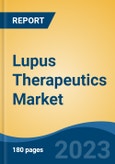Speak directly to the analyst to clarify any post sales queries you may have.
10% Free customizationThis report comes with 10% free customization, enabling you to add data that meets your specific business needs.
Key Market Drivers
Rising Global Prevalence of Systemic Lupus Erythematosus (SLE)
The growing prevalence of systemic lupus erythematosus (SLE), the most common and severe form of lupus, is a significant driver of the lupus therapeutics market. SLE is a chronic autoimmune condition where the immune system mistakenly attacks healthy tissues, resulting in inflammation and organ damage. This condition is especially prevalent among women of reproductive age and is disproportionately seen in African American, Hispanic, and Asian populations. The increasing awareness, improved diagnostic capabilities, and rising incidence of autoimmune disorders globally are collectively contributing to the market’s expansion.Key Market Challenges
High Cost of Advanced Therapies and Limited Access in Low-Income Regions
Despite advancements in treatment, the high cost of biologics and targeted lupus therapies presents a major challenge, particularly in low- and middle-income regions. These innovative drugs, although effective, are often unaffordable for many patients - even in high-income countries with insurance coverage. In regions with limited healthcare infrastructure and funding, access to these treatments remains restricted. The economic burden limits the use of advanced therapeutics, thereby widening the treatment gap. Additionally, constrained healthcare budgets and inadequate reimbursement policies further hinder the adoption of these high-cost medications.Key Market Trends
Growing Adoption of Personalized Medicine in Lupus Treatment
An emerging trend in the lupus therapeutics market is the growing shift toward personalized medicine. This approach tailors treatment to an individual’s genetic, molecular, and phenotypic characteristics. Personalized strategies are especially important in lupus, which is marked by variable symptoms, disease progression, and treatment responses.Advances in genomics, proteomics, and immunophenotyping are enabling more precise patient stratification and treatment planning. For instance, researchers funded by the NIH have identified immune pathway signatures - such as type I interferon activity - that may help predict patient response to specific biologics. Clinical trials are now being designed with biomarker-driven enrollment to increase efficacy, reduce side effects, and streamline drug approvals.
These innovations are supported by government initiatives such as the FDA’s Precision Medicine Initiative and the European Union’s Horizon Europe framework, both of which prioritize the development of targeted therapies for complex diseases like lupus.
Key Market Players
- GSK plc.
- Novartis AG
- AstraZeneca
- F. Hoffmann-La Roche Ltd
- Eli Lilly and Company
- ImmuPharma PLC
- Pfizer Inc.
- Sanofi S.A.
- Bristol-Myers Squibb Company
- Merck & Co., Inc.
Report Scope:
In this report, the Global Lupus Therapeutics Market has been segmented into the following categories, in addition to the industry trends which have also been detailed below:Lupus Therapeutics Market, By Treatment Type:
- NSAIDs
- Corticosteroids
- Antimalarials
- Immunosuppressants
- Biologics
- Others
Lupus Therapeutics Market, By Route of Administration:
- Oral
- Intravenous
- Subcutaneous
Lupus Therapeutics Market, By End User:
- Hospitals & Clinics
- Ambulatory Care Centers
- Others
Lupus Therapeutics Market, By Region:
- North America
- United States
- Mexico
- Canada
- Europe
- France
- Germany
- United Kingdom
- Italy
- Spain
- Asia-Pacific
- China
- India
- South Korea
- Japan
- Australia
- South America
- Brazil
- Argentina
- Colombia
- Middle East and Africa
- South Africa
- Saudi Arabia
- UAE
Competitive Landscape
Company Profiles: Detailed analysis of the major companies present in the Global Lupus Therapeutics Market.Available Customizations:
With the given market data, the publisher offers customizations according to a company's specific needs. The following customization options are available for the report.Company Information
- Detailed analysis and profiling of additional market players (up to five).
This product will be delivered within 1-3 business days.
Table of Contents
Companies Mentioned
- GSK plc.
- Novartis AG
- AstraZeneca
- F. Hoffmann-La Roche Ltd
- Eli Lilly and Company
- ImmuPharma PLC
- Pfizer Inc.
- Sanofi S.A.
- Bristol-Myers Squibb Company
- Merck & Co., Inc.
Table Information
| Report Attribute | Details |
|---|---|
| No. of Pages | 180 |
| Published | July 2025 |
| Forecast Period | 2024 - 2030 |
| Estimated Market Value ( USD | $ 7.12 Billion |
| Forecasted Market Value ( USD | $ 10.74 Billion |
| Compound Annual Growth Rate | 7.0% |
| Regions Covered | Global |
| No. of Companies Mentioned | 10 |









